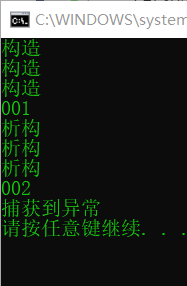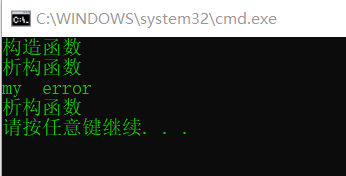一.异常的基本概念
1.异常: 出错后,将出错问题返回给调用处
2.c语言的异常处理比较简单,容易出错(如下),c++处理异常不容易出错
#define _CRT_SECURE_NO_WARNINGS
#include <iostream>
#include <string.h>
#include <string>
using namespace std;
int mydive(int a, int b)
{
if (b == 0)
return -1; //errno = 2
return a / b;
}
void test01()
{
int ret = mydive(1, -1);
if (ret == -1)
{
cout << "除数为0" << endl;//perror("");
}
}
int main() {
test01();
}
二.C++处理异常
异常的基本语法:
#define _CRT_SECURE_NO_WARNINGS
#include <iostream>
#include <string.h>
#include <string>
using namespace std;
int mydive(int a, int b)
{
string str = "hello";
if (b == 0)
throw str;//处理异常 抛出异常 抛出一个类型
return a / b;
}
void test01()
{
//尝试捕获异常
try
{
mydive(2,0);
}
catch (char)//如果没有捕获的抛出的异常 程序会被终止
{
//cout << "捕获了一个char类型的异常" << endl;
throw 'a';
}
catch (int)
{
cout << "捕获了一个int类型的异常" << endl;
}
catch (double)
{
cout << "捕获了一个double类型的异常" << endl;
}
catch (...)
{
cout << "捕获了一个其他类型的异常" << endl;
}
}
int main()
{
try {
test01();
}
catch (char)
{
cout << "捕获了一个char类型的异常" << endl;
}
}
三.栈解旋
在try到throw之间定义的对象,在throw之后会被释放
#define _CRT_SECURE_NO_WARNINGS
#include <iostream>
#include <string.h>
#include <string>
using namespace std;
class Person
{
public:
Person(string name)
{
cout << "构造" << endl;
this->name = name;
}
~Person()
{
cout << "析构" << endl;
}
string name;
};
void fun()
{
Person p2("bob");
Person p3("peter");
cout << "001" << endl;
throw 1;
}
void test01()
{
try
{
Person p1("lucy");
fun();
}
catch (int)
{
cout << "002" << endl;
cout << "捕获到异常" << endl;
}
}
int main()
{
test01();
return 0;
}
结果如下:

四.异常接口声明
一:可以抛掷A,B,C,D和子类型的异常
void fun() throw(A,B,C,D);
二:可以抛掷任意类型的异常
void fun();
三:不可以抛掷任意类型的异常
void fun) throw();
注意:如果抛掷的异常类型和声明的类型不一致,那么会调用unexpected函数,它的默认行为是调用terminate函数终止程序。
五.异常变量生命周期
抛出的匿名对象的生命周期在catch里面
#define _CRT_SECURE_NO_WARNINGS
#include <iostream>
#include <string.h>
#include <string>
using namespace std;
class Myexception
{
public:
Myexception()
{
cout << "构造函数" << endl;
}
~Myexception()
{
cout << "析构函数" << endl;
}
void error()
{
cout << "my error" << endl;
}
};
class Myexception1
{
public:
Myexception1()
{
cout << "构造函数" << endl;
}
~Myexception1()
{
cout << "析构函数" << endl;
}
void error()
{
cout << "my error" << endl;
}
};
void fun()
{
Myexception p1;
//throw Myexception();//如果抛出匿名对象 他的声明周期在catch里面
throw p1;/*p1生命周期在throw之前,实际抛出的是一个匿名对象,也就是说,在抛出的时候会创建一个匿名对象*/
}
void test01()
{
try {
fun();
}
catch (Myexception &p)
{
p.error();
}
catch (Myexception1 &p)
{
p.error();
}
}
int main()
{
test01();
return 0;
}
结果如下:

六.异常的多态使用
1.做法就是抛出任意一个子类,用父类引用或指针去接引
2.这样做的好处在于,当我们一个程序可能有多个类会抛出,这时可能要对各个类进行识别处理,会多次用到catch,这样的代码显得多且杂乱。这时我们只需要给各个类设定一个共同的基类,用虚函数实现异常的多态使用
#define _CRT_SECURE_NO_WARNINGS
#include <iostream>
#include <string.h>
#include <string>
using namespace std;
//基类
class Myexception
{
public:
virtual void error() = 0;
};
class Out_of_range:public Myexception
{
public:
void error()
{
cout << "Out_of_range" << endl;
}
};
class Bad_cast :public Myexception
{
public:
void error()
{
cout << "Bad_cast" << endl;
}
};
void fun()
{
//throw Out_of_range();
throw Bad_cast();
}
void test01()
{
try
{
fun();
}
catch (Myexception &p)
{
p.error();
}
}
int main()
{
test01();
return 0;
}
七.基于C++异常库编写自己的异常类
#define _CRT_SECURE_NO_WARNINGS
#include <iostream>
#include <string.h>
#include <string>
//exception
#include <stdexcept>
using namespace std;
class Longlongerror :public exception
{
public:
Longlongerror(string data)
{
this->data = data;
}
Longlongerror(char * data)
{
this->data = data;
}
const char * what() const
{
return data.c_str(); //将string类强制转换成从const char*
}
string data;
};
void fun()
{
throw Longlongerror("长长的错误");
}
void test01()
{
try
{
fun();
}
catch (exception &p)
{
cout << p.what() << endl;
}
}
int main()
{
test01();
return 0;
}